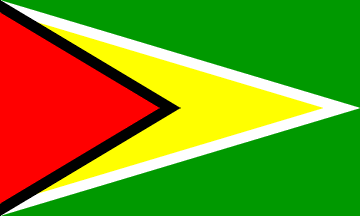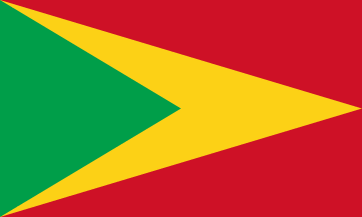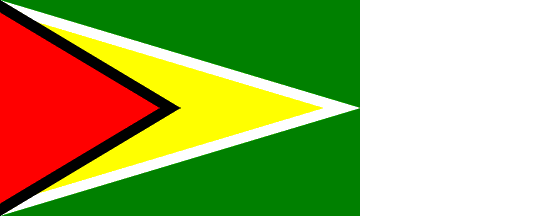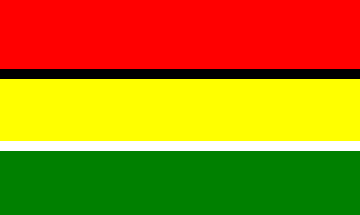 3:5
image by Hemendra Bhola, 25 July 2020 and Zoltan Horvath, 11
June 2024
3:5
image by Hemendra Bhola, 25 July 2020 and Zoltan Horvath, 11
June 2024
Last modified: 2025-11-15 by rob raeside
Keywords: guyana | america | arrow |
Links: FOTW homepage |
search |
disclaimer and copyright |
write us |
mirrors
 3:5
image by Hemendra Bhola, 25 July 2020 and Zoltan Horvath, 11
June 2024
3:5
image by Hemendra Bhola, 25 July 2020 and Zoltan Horvath, 11
June 2024
Official Name: Co-operative Republic of
Guyana
Previous Name: British Guiana
Capital: Georgetown
Flag adopted: 1966
Author: Whitney Smith
Coat of Arms adopted: 1966
See also:
Other sites:
From www.guyana.org:
"The Golden Arrowhead, Guyana's National Flag has FIVE
symbolic colors:
GREEN represents the agricultural and forested nature of
Guyana,
WHITE symbolizes the rivers and water potential of the
country,
GOLDEN arrow represents Guyana's mineral wealth,
BLACK portrays the endurance that will sustain the forward
thrust of the Guyanese people,
RED represents the zeal and dynamic nature of nation-building
which lies before the young and independent Guyana."
Dov Gutterman, 6 January 1999
According to Album 2000 [pay00]
- National Flag (CSW/--- 3:5) - On land the flag is in ratio 3:5,
green with white fimbriated yellow isosceles triangle with base at
hoist and top at fly end, and over it a black fimbriated red
triangle with bas at hoist and top at midpoint of the flag. The
fimbriations are not made along hoist edge, of course.
According to Whitney Smith, the
hoist triangle should reach the midpoint of the flag (and should
not be an equilateral triangle).
Željko Heimer, 27 October 2001
Although I have no correct construction sheet of the Guyana
flag, I've found an interesting data in Ludvik Mucha's book
"Flags and Coats of Arms". According to him, green
color occupies 50% of the flag area, yellow 24%, red 16%, white
6% and black 4%. However, if the red+black triangle reaches the
center of the flag, red+black should occupy 25% (not 20%), and
yellow+white also 25% (not 30%) of the area.
Jan Zrzavy, 7 November 2001
I find the document at www.parliament.gov.gy
which sets out the details. However, it looks really
useless since it provides no drawing or any sort of hint. All it
says is the green is 50", gold 24", white 67" and
the black is 1".
However, it is worth noting that this document confirms the civil
ensign to be in a 1x2 ratio.
Zachary Harden, 27 November 2009
My own spec. for this flag is exactly based upon one by the
late William Crampton, which was in turn taken from the brochure
"Symbols of Nationhood" published on the day of
independence (26 May 1966). I have seen the brochure in the Flag
Institute files but unfortunately failed to take a copy.
William Crampton's specs shows the white pile to be (of course)
the length of the flag whilst the apex of the black triangle
touches the exact centre. In order to show the sizes
of the red and yellow triangles, the spec. gives the white and
black as fimbriations equal to 3/50 the width of the flag.
My memory (such as it is) tells me that these specs are accurate
to the brochure, but I don't have a copy to confirm.
Christopher Southworth, 28 November 2009
I have spent considerable time researching the national flag. One of my
longest projects was the Guyana flag itself - specifically
the layout and
colours. We have to start with a few disadvantages:
1. There is no actual
construction sheet, and even the Schedule to the Constitution which describes
the flag does not provide one.
2. The country has had to contend with
whatever electronic images of the flags are made by users outside the country,
so images which are used on websites canít be said to be authoritative given
that the sites only use what is already there.
3. The color discrepancy
between locally manufactured flags (which involve stitching each color together)
and imported flags which often follow widely circulated images of the flag
online.
In my research, rather than depend on flags already online, I
depended on:
1. A locally made flag I purchased in Guyana and have had in my
possession for over 10 years now.
2. My recollection of the locally made
flags I observed flying from flagpoles at various institutions and even from
local ships and
vessels.
3. A scan of the approved flag in 1966 obtained
from the College of Arms.
4. An image of the first flag raising ceremony at
Independence Day 1966 (grey-scale photo).
5. The original Constitution
Amendment Act (Act No. 6 of 2001) which added the description of the flag to the
schedule of the constitution (black and white scan).
I used numbers 1, 2,
and to some extent 3 for the determination of the closest approximate colours
AND numbers 1, 2, 3, 4, and 5 to determine the closest proportional sizing of
the black and white fimbriations to the rest of the flag.
Based on the
above, I have found:
COLOURS:
1. The colours on the flag are less
fluorescent than widely seen online.
2. The gold is deeper and more vibrant.
This is critical as the flag identifies this color as Gold. While some may argue
that in heraldry
there is no difference, the distinction was made in regards
to the Guyana flag on approval and the incorrect usage of yellow can be said to
have contributed to incorrectly colored flags - especially those with an almost
safety vest yellow.
3. The green is in a mid position - its not very dark nor
can it be said to be light.
4. The red is slightly deeper but not overly
dark.
PROPORTIONS OF BLACK AND WHITE FIMBRIATIONS:
1. All of the
examples demonstrated that the fimbriations are not as wide as generally
portrayed.
2. While there are slight variations in regards to the observed
locally made flags, the scan from the College of Arms, the Constitution
Amendment Act, and even the image of the independence flag raising in 1966 these
variations are minute of each other and do not support the current belief that
the fimbriations are as wide as commonly drawn.
Hemendra Bhola, 25 July 2020
The closest approximate colours are:
Hemendra Bhola, 25 July 2020
An approximate construction being (also applicable for 3:5 by modifying B and C to 25 and 50 respectively and keeping the remaining measurements):
 image by Hemendra Bhola, 25
July 2020
image by Hemendra Bhola, 25
July 2020
Another fact I came across from a video of independence days, was a segment
on the design of the flag. In an interview with one of the members of the design
committee, she noted that the committee liked Smithís arrangement, but solicited
other colours to substitute using the Smith design. In the end the committee
opted to keep Smithís design and reverse the red and green. It was then noted
that on presenting this to one of the artists on the committee they remarked
that they didnít see anything symbolic of the waters and rivers. The white was
then added and to balance it out black was added as well. The design was given a
name and symbolism attached to the colours, and was then sent to the College of
Arms.
So we now know that the black and white were
never added by the college.
Hemendra Bhola, 25 July 2020
 image by Kazutaka Nishiura, 03 March 2014
image by Kazutaka Nishiura, 03 March 2014
The black and white fimbriations were not in Whitney Smith's
original design, but were added by the English College of Arms.
Can't see why, as the flag wasn't disobeying the
colour-on-colour/metal-on-metal rule before (it does now!).
Roy Stilling, 1 October 1996 and 14 May 1997
The current flag of Guyana was designed in 1962 by an
American, Mr. Whitney Smith, and was the result of an
international competition held by the then government. (The year
1962 was expected to be "Independence Year"). The
design was NEVER CHANGED by the new government which took office
in December 1964. This flag of Guyana, since 1966, became known
as the "Golden Arrowhead."
Amb. Odeen Ishmael, Guyana Embassy - Washington DC, 18
December 2000
In DK's Complete Flags of the World (1999) [udk99] I read: 'The original design
had a red field, but this was altered by the College of Arms (in
England) in 1966, which also added the black and white
fimbriations.' That is corroborated in Crampton's FOTW (1990) [cra90i] and by Roy Stilling.
Jarig Bakker, 18 December 2000
Just a clarification: "The original design had a red
field" - I assume it means: 'green triangle on yellow arrow
on red field' and not 'red triangle on yellow arrow on red
field'.
Ole Andersen, 18 December 2000
1)  image by André Pires Godinho, 1 June 2003
image by André Pires Godinho, 1 June 2003
2)  image by André Pires Godinho, 1 June 2003
image by André Pires Godinho, 1 June 2003
I saw a picture of Georgetown in the day of the independence
of Guyana, in this picture is showed two flags, I don't know if
these flags are still in use, but these flags are a more used in
this commemoration than the national one.
The first is the national flag with an extension in white, the
size of the extension is approximately 1/2 of the national flag
The second is a flag with three horizontal stripes in the colors
red, yellow and green with black and white fimbriations between
the stripes.
So this is the ask...someone know the use or the meaning of these
flags?
André Pires Godinho, 1 June 2003
As to the second: My guess is that it is an inexpensive,
easily sewn celebratory flag which displays the national colors.
The arrowhead design is striking, but not easily stitched at
home. People without a copy of the national flag might have
elected to create the horizontal design which is easy to assemble
with a sewing machine.
Al Kirsch, 1 June 2003
The Constitution of Guyana defines the national and illustrates it (Second
Schedule):
https://parliament.gov.gy/Constitution%20of%20the%20Cooperatiive%20Republic%20of%20Guyana.pdf
(Page 260). However, I found two more versions of the Constitution with
different illustrations (and with different shades of colors):
https://www.oas.org/juridico/spanish/mesicic2_guy_constitution.pdf
(Page 201) (darker green)
https://gcci.gy/wp-content/uploads/2013/07/Constitution-of-Guyana.pdf (Page
212) (lighter green)
So, I tried to find pictorial evidences of flag
colors, and I have had an interesting experience. There are pictures in teh
environment of high officials, especially the president.
Images of flag:
Light shade of green:
https://www.guyanaembassy-kuwait.com/presidents-of-guyana/
https://guyanachronicle.com/2022/04/18/president-of-the-co-operative-republic-of-guyana-dr-irfaan-ali/
https://www.guyanamissiongeneva.ch/meeting-between-president-mohamed-irfaan-ali-and-un-secretary-general/
https://oilnow.gy/featured/guyana-in-us2-billion-mou-with-united-states-exim-bank/
Medium shade of colors:
https://oilnow.gy/featured/suriname-president-for-guyana-state-visit-this-month/
https://www.instagram.com/visitguyana/p/C5_HqeLrolv/?img_index=1
https://guyanatimesgy.com/guyana-to-start-negotiation-on-gas-to-energy-project-vice-president/
https://www.hinduamerican.org/press/new-guyana-president-mohamed-irfaan-ali
Very dark shade of colors:
https://op.gov.gy/index.php/presidents-biography/
https://op.gov.gy/index.php/2022/05/06/guyana-and-brazil-agree-on-actionable-framework-president-ali
(Note: yellow and green are darker than Brazilian flagís yellow and green)
https://www.instagram.com/opguyana/p/C18CEhqrCN-/?img_index=1
https://www.timesnownews.com/world/stop-lecturing-me-indian-origin-guyana-president-shuts-down-bbc-journalist-video-goes-viral-article-108901290
https://guyanatimesgy.com/guyana-positioning-to-influence-major-global-decisions-contribute-to-intl-leadership-pres-ali/
https://www.youtube.com/watch?v=kz6zDMbhKsU
Based on my
observations, older pictures displayed lighter or medium shades of colors, the
green and yellow have different shades on various pictures, while newer pictures
(taken in last year or in this year) shows a really very dark shade of green.
Zoltan Horvath, 11 June 2024
The protocol manual for the
London 2012 Olympics
(Flags and Anthems Manual
London 2012 [loc12]) provides recommendations
for national flag designs. Each
NOC
was sent an image of the flag, including the
PMS shades, for their approval by LOCOG. Once this was obtained, LOCOG produced
a 60 x 90 cm version of the flag for further approval. So, while these specs may
not be the official, government, version of each flag, they are certainly what
the NOC
believed the flag to be.
For Guyana: PMS 032 red, 109 yellow, 355 green and black. The vertical flag is
simply the horizontal version turned 90 degrees clockwise.
Ian Sumner, 10 October 2012
Other sources for colors:
The Flag Manual - Beijing 2008 gives Pantone
colors: PMS 032 (red), PMS 355 (green), PMS 102 (yellow), and PMS Black.
The Album des Pavillons 2000 [pay00] (Corr. No.
5.) gives approximate color in Pantone and CMYK systems:
Red: Pantone 186c,
CMYK 0-90-80-5
Yellow: Pantone 116c, CMYK 0-15-95-0
Green: Pantone 355c,
CMYK 100-0-90-0
The Album des Pavillons 2023 already specifies the color
of the flags in three color systems.
Blue: Pantone 2965c, CMYK 100-91-43-51,
RGB 0-20-67
Blue: Pantone 292c, CMYK 59-17-0-0, RGB 106-178-231
Red:
Pantone 186c, CMYK 14-100-79-4, RGB 200-16-46
Grey: Pantone 429c, CMYK
37-24-24-4, RGB 168-176-180
Grey: Pantone 435c, CMYK 30-34-24-5, RGB
183-166-173
Yellow: Pantone 116c, CMYK 0-21-93-0, RGB 255-204-0
Green:
Pantone 355c, CMYK 84-12-100-1, RGB 0-149-48
Vexilla Mundi gives colors in Pantone
system: PMS 186C (red), PMS 108C (yellow), PMS 354C (green), PMS White, and PMS
Black.
Wikipedia
illustrates construction details, but doesnít give any color specification.
Flag Color Codes gives the following color values:
Red: Hex. # EF3340, RGB 239-51-64, CMYK 0-90-76-0, Pantone 032, RAL 3024
Black: Hex. # 000000, RGB 0-0-0, CMYK 0-0-0-100, Pantone Black, RAL 9005
Yellow: Hex. # FFD100, RGB 255-209-0, CMYK 0-5-100-0, Pantone 109, RAL 2007
White: Hex. # FFF FFF, RGB 255-255-255, CMYK 0-0-0-0, Pantone N/A, RAL N/A
Green: Hex. # 009739, RGB 0-151-57, CMYK 93-0-100-0, Pantone 355, RAL 6037
I consulted Hemendra Bhola and we agreed colors of national flag of Guyana as follows:
Red: Pantone 200C, CMYK 15-100-90-10, RGB 191-49-36
Gold: Pantone
123C, CMYK 0-20-100-0, RGB 254-204-0
Green: Pantone 356C, CMYK
100-25-100-25, RGB 0-109-59
Blue: Pantone 654C, CMYK 100-90-10-40, RGB
42-48-97 (for Presidential standard)
Zoltan Horvath, 11 June 2024
There are no established shades of the flag. Only the five colors are set,
with the one caveat that the gold on the flag is always described as gold and
never yellow. I have in the past tried to come up with what I think the closest
shades are, but even Iím not 100% satisfied given the many varieties found.
The absence of official shades had resulted in flag manufacturers taking
liberties with the shades and the result is a range of flags with almost
fluorescent colors to very dark.
Mass-produced imported flags tend to be
on the lighter shade while locally produced flags have a wider variety depending
on the fabric they have on hand at a given time. One company in Guyana used to
manufacture printed national flags and when I think of it, this would be the
closest to what I think the shades ought to be.
Sadly the images in the
constitution are mostly illustrative and not authoritative, as the intent was
just to include an image of the flag. This meant that an image from the internet
was pulled whenever one was needed for a publication of the constitution.
In regards to the examples of the shades you found, the light and medium
shades are all foreign-produced flags while all examples of the dark shade are
from the same local manufacturer. However, this does not make it authoritative,
as Iím sure you have noticed, the stitching of the black and white fimbriations
are so haphazard that the flag looks very unprofessional. There is at least one
other local flag manufacturer who produces flags with the correct width
fimbriations, although with color swatch variations, but for some reason some of
the government agencies seem to be procuring the poorly made flags these days,
as seen in the dark shade images you linked.
Hemendra Bhola, 11 June
2024
The Guyana National Pledge, as reproduced on the TUF website,
mentions the national flag (in the first position):
"I pledge myself to honour always the flag of Guyana, and to
be loyal to my country, to be obedient to the laws of Guyana, to
love my fellow citizens, and to dedicate my energies towards the
happiness and prosperity of Guyana."
Ivan Sache, 29 September, 2007